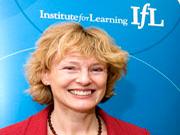Quantum physics and why new teachers cry

In recent discussions with several very experienced and successful teachers and trainers, I was surprised to learn how many remembered succumbing to anguish and tears in the early years of their teaching careers, when they were learning the job. I count myself as one of them.
The first years of teaching or training can be especially challenging, exhilarating and sometimes feel like facing a series of shock waves. The myriad and intensity of demands made on the teacher or trainer from learners, peers, managers and others – every minute, every hour and every day – can be energising, and also, as the weeks go by, increasingly enervating. This can reduce the strongest person to tears.
Teachers and trainers are clear that their top priority is to ensure successful learning, and they are on the front foot with preparing and making sure this happens well. As responsible professionals, teachers and trainers also give careful thought to when to respond to demands from management or peers, how best to respond, and possibly whether not to respond, or at least only after more consideration. Sometimes, if a learner arrives late and disrupts others, for example, or it looks as though a serious altercation might be brewing up, responses must be instant.
Readers will recognise the ‘push-me pull-you’ dynamic and tensions between planning and reacting, which apply in all walks of working life. In teaching and training, however, the pendulum swings with exceptional speed and unpredictability. Which other professions require that in the first week you get to know the names of, say, between 300 and 400 individuals and work out how to engage them positively in new activities and new groupings that are not familiar to them – or you?
The intensity of hundreds of interpersonal interactions when you are in charge as a teacher is incredible – it has to be experienced to be believed. Good teaching and training demands vast intellectual effort and focus on planning and teaching, always accompanied by thinking hard about which teaching and training methods are most likely to work, which actually did work best, which learners were grasping the new concepts, who was struggling and why, and how to adapt and develop approaches so that each learner learns most effectively.
So what is the link between being new to teaching and training and quantum physics?
Recently, when listening to Basil Hiley, emeritus professor of physics at Birkbeck, University of London, it struck me that the very different world orders of classical physics and quantum physics mirror the difference between non-teachers’ views of teaching and learning (akin to classical physics) and the views of professional teachers and trainers (akin to the multiple realities of both classical and quantum physics). People’s sense of ‘the ordinary’ is in the domain of classical physics.
Let me explain. Imagine a billiard table; we know intuitively that when the cue hits a ball, the ball will follow a certain path at a certain speed and ricochet in predictable ways. This is classical physics in action. I think those who are not teachers and trainers, but of course have been pupils or adult learners, see teaching and learning in this way, as having a pretty straightforward and logical set of chain reactions.
The teacher or trainer, however, also needs to and is operating at the level of atoms, as in quantum physics. In this reality, and with the logic of quantum physics, the cue hits the billiard ball (an atom) which then may go straight through the cushion, or bounce back up the arm of the person holding the cue, or bounce up into the air. It may or may not return to the table, or do many other unusual things.
Just as the billiard table may appear more straightforward on the surface, so teaching and training can look deceptively simple to those who have received education but have not taught.
Teachers and trainers who are deeply professional and lead their complex work with very diverse learners know and harness the realities at classical and quantum, macro and micro levels, so each of their learners succeeds.
Policymakers focus on the macro level and rightly so. They do, however, need to recognise and promote the high levels of expertise needed by teachers to operate well at the complex, very demanding and less predictable micro level with learners. Trusting and valuing teaching professionals, and teachers helping each other, are important guiding principles. A key role for leaders is to step aside to give the leadership of learning to teachers and trainers.
Between 15,000 and 20,000 new teachers and trainers join the further education and skills sector each year. If you know a teacher or trainer in their first year or so of practice, please remember just how big a professional learning curve they are going through. Support them and celebrate what they do. Remember that they are doing their best to get to grips with the multiple realities in their classrooms and workshops in order to lead learning for their learners with authority and aplomb at all levels of the experience.
To stay with the physics analogy, they are playing four-dimensional billiards with 300 to 400 learners on the table. This is hard – and awesome.
(With thanks to Sir John Holman, Director, National Science Learning Centre, for his advice on my references to physics in the article. Any errors are, of course, my own.)
Toni Fazaeli is the chief executive of the IfL, the professional body for more than 200,000 teachers, trainers, tutors and student teachers across the Further Education and Skills sector
Read other FE News articles by Toni Fazaeli:
The role of professionals in times of scarce resourcing
Looking for hope in the Budget
Professional teaching and training is crucial to the nation’s economic and social ambitions











Responses